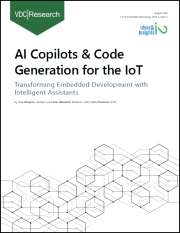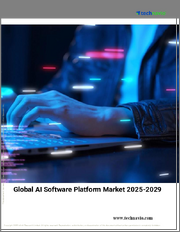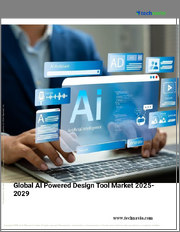
|
시장보고서
상품코드
1611936
세계의 AI 코드 툴 시장 : 기술, 전개, 용도, 조직 규모, 업종별 예측(2025-2030년)AI Code Tools Market by Technology (Generative AI, Machine Learning, Natural Language Processing), Deployment (Cloud-Based, Hybrid, On-Premises), Application, Organization Size, Vertical - Global Forecast 2025-2030 |
||||||
AI 코드 툴 시장의 2023년 시장 규모는 216억 9,000만 달러로 평가되었습니다. 2024년에는 251억 2,000만 달러에 이를 것으로 예측되며, 복합 연간 성장률(CAGR) 16.86%로 성장하여, 2030년에는 645억 6,000만 달러에 달할 것으로 예상됩니다.
AI 코드 도구는 인공지능 기술을 사용한 코드 작성, 디버깅 및 최적화에서 개발자를 지원하기 위해 설계된 소프트웨어 솔루션입니다.이 도구는 반복적인 코딩 작업을 자동화하고 지능적입니다. 추천 제공 생산성을 대폭 향상시키고 에러를 줄이기 위해 필요합니다. 최종 사용자에게 서비스를 제공합니다.
| 주요 시장 통계 | |
|---|---|
| 기준년(2023) | 216억 9,000만 달러 |
| 추정년(2024) | 251억 2,000만 달러 |
| 예측년(2030) | 645억 6,000만 달러 |
| 복합 연간 성장률(CAGR)(%) | 16.86% |
AI 코드 툴 시장은 효율적인 소프트웨어 개발 프로세스에 대한 수요 증가, IT 업무의 AI 통합 증가, 머신 러닝 용도의 급성장에 의해 견인되고 있습니다. 노력의 급증, 복잡한 프로그래밍 언어의 보급, 숙련된 개발자의 부족 등이 있습니다. 모두가 코딩 작업을 효율화할 수 있는 도구의 필요성을 강조하고 있습니다. 생산성을 높이는 것, 자연언어 처리의 진보를 이용하여 코드 생성을 보다 직관적으로 하는 것입니다.
그러나 시장의 한계는 구독과 라이선싱의 초기 비용이 높고, 신뢰 문제에서 AI에 의존하는 것을 망설이는 개발자의 잠재적 저항, 데이터의 프라이버시와 보안 유지에 있어서의 과제 등을 들 수 있습니다. 경쟁 구도도 과제가 되고 있어, 복수의 벤더가 중복하는 기능을 제공하고 있기 때문에 차별화가 매우 중요해지고 있습니다.
보다 정확한 코드를 생성하기 위해, 보다 컨텍스트를 이해한 AI 모델의 개발, 보다 정교한 디버그 기능의 개발, 기존의 개발 환경과의 상호 운용성의 강화 등, 혁신과 연구의 기회는 풍부하게 또한 클라우드 기반 플랫폼과의 더 나은 통합 홍보를 통해 원활한 실행과 배포 기회를 제공합니다. AI 코드 도구 시장은 급속한 혁신과 지속적인 혁신에 대한 강한 주력을 특징으로하는 역동적인 시장으로 기업에 개발 효율성과 비용 절감 개선과 성장을 위한 큰 여지를 제공합니다.
시장 역학 : 빠르게 진화하는 AI 코드 도구 시장의 주요 시장 인사이트 공개
AI 코드 툴 시장은 수요 및 공급의 역동적인 상호작용에 의해 변모를 이루고 있습니다. 새로운 비즈니스 기회를 획득할 수 있습니다. 이러한 동향을 종합적으로 파악함으로써 기업은 정치적, 지리적, 기술적, 사회적, 경제적 영역에 걸친 다양한 리스크를 경감할 수 있을 뿐만 아니라 소비자 행동과 그것이 제조 비용과 구매 동향에 미치는 영향을보다 명확하게 이해할 수 있습니다.
- 시장 성장 촉진요인
- 소프트웨어 개발 효율 향상을 위한 고성능 AI 코드 툴에 대한 요구
- AI 인프라에 대한 정부의 적극적인 대처와 투자
- 폭넓은 업계에 있어서의 AI 코드 툴의 이용 확대
- 시장 성장 억제요인
- AI 인프라 설계, 배포, 유지 보수의 복잡성
- 시장 기회
- AI 인프라의 새로운 기술 통합과 발전
- 머신러닝 알고리즘의 강화와 AI 코드 툴의 크로스 플랫폼 호환성
- 시장의 과제
- 데이터 프라이버시의 문제, 사이버 공격에 대한 취약성
Porter's Five Forces : AI 코드 도구 시장을 탐색하는 전략 도구
Porter's Five Forces Framework는 AI 코드 도구 시장 경쟁 구도를 이해하는 중요한 도구입니다. Porter's Five Forces Framework는 기업의 경쟁력을 평가하고 전략적 기회를 탐구하는 명확한 기술을 제공합니다. 이 프레임워크는 기업이 시장 내 세력도를 평가하고 신규 사업의 수익성을 판단하는 데 도움이 됩니다. 이러한 인사이트을 통해 기업은 자사의 강점을 활용하고 약점을 해결하고 잠재적인 과제를 피함으로써 보다 강인한 시장에서의 포지셔닝을 확보할 수 있습니다.
PESTLE 분석 : AI 코드 툴 시장에서 외부로부터의 영향 파악
외부 거시 환경 요인은 AI 코드 도구 시장의 성과 역학을 형성하는 데 매우 중요한 역할을 합니다. 정치적, 경제적, 사회적, 기술적, 법적, 환경적 요인 분석은 이러한 영향을 탐색하는 데 필요한 정보를 제공합니다. PESTLE 요인을 조사함으로써 기업은 잠재적인 위험과 기회를 더 잘 이해할 수 있습니다. 이 분석을 통해 기업은 규제, 소비자 선호, 경제 동향의 변화를 예측하고 앞으로 예상되는 적극적인 의사 결정을 할 준비가 가능합니다.
시장 점유율 분석 AI 코드 도구 시장 경쟁 구도 파악
AI 코드 툴 시장의 상세한 시장 점유율 분석을 통해 공급업체의 성과를 종합적으로 평가할 수 있습니다. 기업은 수익, 고객 기반, 성장률 등 주요 지표를 비교하여 경쟁 포지셔닝을 밝힐 수 있습니다. 이 분석을 통해 시장 집중, 단편화, 통합 동향을 밝혀내고 벤더들은 경쟁이 치열해지는 가운데 자사의 지위를 높이는 전략적 의사 결정을 내리는 데 필요한 지식을 얻을 수 있습니다.
FPNV 포지셔닝 매트릭스 AI 코드 도구 시장에서 공급업체의 성능 평가
FPNV 포지셔닝 매트릭스는 AI 코드 툴 시장에서 벤더를 평가하기 위한 중요한 툴입니다. 이 행렬을 통해 비즈니스 조직은 공급업체의 비즈니스 전략과 제품 만족도를 기준으로 평가하여 목표에 맞는 충분한 정보를 바탕으로 의사 결정을 내릴 수 있습니다. 네 가지 사분면을 통해 공급업체를 명확하고 정확하게 세분화하여 전략 목표에 가장 적합한 파트너 및 솔루션을 파악할 수 있습니다.
전략 분석 및 권장 AI 코드 도구 시장에서 성공을 위한 길을 그리기
AI 코드 툴 시장의 전략 분석은 시장에서의 프레즌스 강화를 목표로 하는 기업에 필수적인 요소입니다. 이 접근법을 통해 경쟁 구도에서 과제를 극복하고 새로운 비즈니스 기회를 활용하여 장기적인 성공을 거둘 수 있는 체제를 구축할 수 있습니다.
이 보고서는 주요 관심 분야를 포괄하는 시장의 종합적인 분석을 제공합니다.
1. 시장 침투 : 현재 시장 환경의 상세한 검토, 주요 기업의 광범위한 데이터, 시장 도달범위 및 전반적인 영향력 평가.
2. 시장 개척도 : 신흥 시장의 성장 기회를 파악하고 기존 분야의 확장 가능성을 평가하며 미래 성장을 위한 전략적 로드맵을 제공합니다.
3. 시장 다양화 : 최근 제품 출시, 미개척 지역, 업계의 주요 진보, 시장을 형성하는 전략적 투자를 분석합니다.
4. 경쟁 평가 및 정보 : 경쟁 구도를 철저히 분석하여 시장 점유율, 사업 전략, 제품 포트폴리오, 인증, 규제 당국 승인, 특허 동향, 주요 기업의 기술 진보 등을 검증합니다.
5. 제품 개발 및 혁신 : 미래 시장 성장을 가속할 것으로 예상되는 최첨단 기술, R&D 활동, 제품 혁신을 강조합니다.
또한 이해관계자가 충분한 정보를 얻고 의사결정을 할 수 있도록 중요한 질문에 대답하고 있습니다.
1. 현재 시장 규모와 향후 성장 예측은?
2. 최고의 투자 기회를 제공하는 제품, 부문 및 지역은 어디입니까?
3. 시장을 형성하는 주요 기술 동향과 규제의 영향은?
4. 주요 벤더의 시장 점유율과 경쟁 포지션은?
5. 벤더 시장 진입, 철수 전략의 원동력이 되는 수익원과 전략적 기회는 무엇인가?
목차
제1장 서문
제2장 조사 방법
제3장 주요 요약
제4장 시장 개요
제5장 시장 인사이트
- 시장 역학
- 성장 촉진요인
- 소프트웨어 개발의 효율화를 도모하기 위한 고성능의 AI 코드 툴의 필요성
- AI 인프라에 대한 정부의 바람직한 이니셔티브와 투자
- 폭넓은 업계에서 AI 코드 툴의 이용을 확대
- 억제요인
- AI 인프라 설계, 배치, 유지 보수의 복잡성
- 기회
- AI 인프라의 새로운 기술 통합과 발전
- 머신러닝 알고리즘의 강화와 AI 코드 툴의 크로스 플랫폼 호환성
- 과제
- 데이터 프라이버시의 문제와 사이버 공격에 대한 취약성
- 성장 촉진요인
- 시장 세분화 분석
- 기술 : 고객 행동 및 비즈니스 패턴을 분석하기 위한 머신러닝 기술 채택
- 도입 : 운영 유연성을 높이기 위해 클라우드 기반 도입을 우선
- 응용 : AI 코드 도구는 이러한 응용 분야에 필수적이며 효율성과 혁신성을 향상시킵니다.
- 조직 규모 : 대규모 비즈니스에서 신속한 의사 결정 프로세스를 촉진하는 고급 AI 모델을 권장
- 수직: 업계 수직 전체에서의 이용률의 향상
- Porter's Five Forces 분석
- PESTEL 분석
- 정치적
- 경제
- 사교
- 기술적
- 법률상
- 환경
제6장 AI 코드 툴 시장 : 기술별
- 생성형 AI
- 머신러닝
- 자연어처리
제7장 AI 코드 툴 시장 : 전개별
- 클라우드 기반
- 하이브리드
- 온프레미스
제8장 AI 코드 툴 시장 : 용도별
- 클라우드 서비스와 DevOps
- 데이터 과학
- 임베디드 시스템
- 게임 개발
- 모바일 앱 개발
- 웹 개발
제9장 AI 코드 툴 시장 : 조직 규모별
- 대기업
- 중소기업
제10장 AI 코드 툴 시장 : 업계별
- 은행, 금융, 보험
- 정부 및 공공 부문
- 헬스케어
- IT 및 통신
- 제조업
- 미디어 및 엔터테인먼트
- 소매업 및 전자상거래
제11장 아메리카의 AI 코드 툴 시장
- 아르헨티나
- 브라질
- 캐나다
- 멕시코
- 미국
제12장 아시아태평양의 AI 코드 툴 시장
- 호주
- 중국
- 인도
- 인도네시아
- 일본
- 말레이시아
- 필리핀
- 싱가포르
- 한국
- 대만
- 태국
- 베트남
제13장 유럽, 중동 및 아프리카의 AI 코드 툴 시장
- 덴마크
- 이집트
- 핀란드
- 프랑스
- 독일
- 이스라엘
- 이탈리아
- 네덜란드
- 나이지리아
- 노르웨이
- 폴란드
- 카타르
- 러시아
- 사우디아라비아
- 남아프리카
- 스페인
- 스웨덴
- 스위스
- 터키
- 아랍에미리트(UAE)
- 영국
제14장 경쟁 구도
- 시장 점유율 분석(2023년)
- FPNV 포지셔닝 매트릭스(2023년)
- 경쟁 시나리오 분석
- Bito, 개발자의 코드 베이스를 이해하는 AI를 발표
- Meta가 커뮤니티 라이선스의 AI 코딩 툴을 일반 공개
- IBM, 메인프레임 용도의 근대화를 가속화하는 Watsonx 생성형 AI 기능을 발표
- 전략 분석과 제안
기업 목록
- AI Repo
- Amazon Web Services, Inc.
- AskCodi
- Bugasura
- ChatGPT by OpenAI
- ClickUp
- Code Intelligence
- Code Llama by Meta Platforms, Inc.
- CodeWP
- Codiga by Datadog
- Divi AI
- GitHub Copilot by Microsoft Corporation
- Keras
- PyCharm by JetBrains sro
- Replit
- Safurai
- SinCode AI
- Snyk Code
- TabNine Inc.
- TensorBoard
- TensorFlow
- Watsonx by International Business Machines Corporation
- Wing IDE
The AI Code Tools Market was valued at USD 21.69 billion in 2023, expected to reach USD 25.12 billion in 2024, and is projected to grow at a CAGR of 16.86%, to USD 64.56 billion by 2030.
AI code tools are software solutions designed to assist developers in writing, debugging, and optimizing code using artificial intelligence technologies. These tools are necessary as they significantly enhance productivity and reduce errors by automating repetitive coding tasks and providing intelligent recommendations. They are applied across various sectors, including software development, data science, and IT operations, and serve end-users ranging from individual developers to large enterprises.
| KEY MARKET STATISTICS | |
|---|---|
| Base Year [2023] | USD 21.69 billion |
| Estimated Year [2024] | USD 25.12 billion |
| Forecast Year [2030] | USD 64.56 billion |
| CAGR (%) | 16.86% |
The market for AI code tools is driven by the increasing demand for efficient software development processes, rising integration of AI in IT operations, and the rapid growth of machine learning applications. Key growth factors include the surge in digital transformation initiatives, the proliferation of complex programming languages, and the ongoing shortage of skilled developers, all of which underline the need for tools capable of streamlining coding efforts. The latest opportunities lie in expanding tool capabilities to support a wider array of programming languages, integrating with collaborative platforms to enhance real-time team productivity, and harnessing advancements in natural language processing to make code generation more intuitive.
However, market limitations include high initial subscription or licensing costs, potential resistance from developers hesitant to rely on AI due to trust issues, and challenges in maintaining data privacy and security. The competitive landscape also poses a challenge, with multiple vendors offering overlapping functionalities, making differentiation crucial.
Innovation and research opportunities abound in developing AI models with better contextual understanding to produce more accurate code, creating more sophisticated debugging features, and enhancing interoperability with existing development environments. Furthermore, fostering better integration with cloud-based platforms presents opportunities for seamless execution and deployment. The AI code tools market is dynamic, characterized by rapid technological advancements and a strong focus on continuous innovation, thus offering businesses substantial scope for growth and improvement in development efficiency and cost reduction.
Market Dynamics: Unveiling Key Market Insights in the Rapidly Evolving AI Code Tools Market
The AI Code Tools Market is undergoing transformative changes driven by a dynamic interplay of supply and demand factors. Understanding these evolving market dynamics prepares business organizations to make informed investment decisions, refine strategic decisions, and seize new opportunities. By gaining a comprehensive view of these trends, business organizations can mitigate various risks across political, geographic, technical, social, and economic domains while also gaining a clearer understanding of consumer behavior and its impact on manufacturing costs and purchasing trends.
- Market Drivers
- Need for high-performance AI code tools to enhance software development efficiency
- Favorable government initiatives and investments in AI infrastructure
- Broadening use of AI code tools across wide range of industries
- Market Restraints
- Complexity of designing, deploying, and maintaining AI infrastructure
- Market Opportunities
- New technological integration and advancements in AI infrastructure
- Enhancements in machine learning algorithms & cross-platform compatibility of AI code tools
- Market Challenges
- Data privacy issues & vulnerability to cyberattacks
Porter's Five Forces: A Strategic Tool for Navigating the AI Code Tools Market
Porter's five forces framework is a critical tool for understanding the competitive landscape of the AI Code Tools Market. It offers business organizations with a clear methodology for evaluating their competitive positioning and exploring strategic opportunities. This framework helps businesses assess the power dynamics within the market and determine the profitability of new ventures. With these insights, business organizations can leverage their strengths, address weaknesses, and avoid potential challenges, ensuring a more resilient market positioning.
PESTLE Analysis: Navigating External Influences in the AI Code Tools Market
External macro-environmental factors play a pivotal role in shaping the performance dynamics of the AI Code Tools Market. Political, Economic, Social, Technological, Legal, and Environmental factors analysis provides the necessary information to navigate these influences. By examining PESTLE factors, businesses can better understand potential risks and opportunities. This analysis enables business organizations to anticipate changes in regulations, consumer preferences, and economic trends, ensuring they are prepared to make proactive, forward-thinking decisions.
Market Share Analysis: Understanding the Competitive Landscape in the AI Code Tools Market
A detailed market share analysis in the AI Code Tools Market provides a comprehensive assessment of vendors' performance. Companies can identify their competitive positioning by comparing key metrics, including revenue, customer base, and growth rates. This analysis highlights market concentration, fragmentation, and trends in consolidation, offering vendors the insights required to make strategic decisions that enhance their position in an increasingly competitive landscape.
FPNV Positioning Matrix: Evaluating Vendors' Performance in the AI Code Tools Market
The Forefront, Pathfinder, Niche, Vital (FPNV) Positioning Matrix is a critical tool for evaluating vendors within the AI Code Tools Market. This matrix enables business organizations to make well-informed decisions that align with their goals by assessing vendors based on their business strategy and product satisfaction. The four quadrants provide a clear and precise segmentation of vendors, helping users identify the right partners and solutions that best fit their strategic objectives.
Strategy Analysis & Recommendation: Charting a Path to Success in the AI Code Tools Market
A strategic analysis of the AI Code Tools Market is essential for businesses looking to strengthen their global market presence. By reviewing key resources, capabilities, and performance indicators, business organizations can identify growth opportunities and work toward improvement. This approach helps businesses navigate challenges in the competitive landscape and ensures they are well-positioned to capitalize on newer opportunities and drive long-term success.
Key Company Profiles
The report delves into recent significant developments in the AI Code Tools Market, highlighting leading vendors and their innovative profiles. These include AI Repo, Amazon Web Services, Inc., AskCodi, Bugasura, ChatGPT by OpenAI, ClickUp, Code Intelligence, Code Llama by Meta Platforms, Inc., CodeWP, Codiga by Datadog, Divi AI, GitHub Copilot by Microsoft Corporation, Keras, PyCharm by JetBrains s.r.o., Replit, Safurai, SinCode AI, Snyk Code, TabNine Inc., TensorBoard, TensorFlow, Watsonx by International Business Machines Corporation, and Wing IDE.
Market Segmentation & Coverage
This research report categorizes the AI Code Tools Market to forecast the revenues and analyze trends in each of the following sub-markets:
- Based on Technology, market is studied across Generative AI, Machine Learning, and Natural Language Processing.
- Based on Deployment, market is studied across Cloud-Based, Hybrid, and On-Premises.
- Based on Application, market is studied across Cloud Services & DevOps, Data Science, Embedded Systems, Gaming Development, Mobile App Development, and Web Development.
- Based on Organization Size, market is studied across Large Enterprises and Small & Medium Enterprises.
- Based on Vertical, market is studied across Banking, Finance & Insurance, Government & Public Sector, Healthcare, IT & Telecommunications, Manufacturing, Media & Entertainment, and Retail & eCommerce.
- Based on Region, market is studied across Americas, Asia-Pacific, and Europe, Middle East & Africa. The Americas is further studied across Argentina, Brazil, Canada, Mexico, and United States. The United States is further studied across California, Florida, Illinois, New York, Ohio, Pennsylvania, and Texas. The Asia-Pacific is further studied across Australia, China, India, Indonesia, Japan, Malaysia, Philippines, Singapore, South Korea, Taiwan, Thailand, and Vietnam. The Europe, Middle East & Africa is further studied across Denmark, Egypt, Finland, France, Germany, Israel, Italy, Netherlands, Nigeria, Norway, Poland, Qatar, Russia, Saudi Arabia, South Africa, Spain, Sweden, Switzerland, Turkey, United Arab Emirates, and United Kingdom.
The report offers a comprehensive analysis of the market, covering key focus areas:
1. Market Penetration: A detailed review of the current market environment, including extensive data from top industry players, evaluating their market reach and overall influence.
2. Market Development: Identifies growth opportunities in emerging markets and assesses expansion potential in established sectors, providing a strategic roadmap for future growth.
3. Market Diversification: Analyzes recent product launches, untapped geographic regions, major industry advancements, and strategic investments reshaping the market.
4. Competitive Assessment & Intelligence: Provides a thorough analysis of the competitive landscape, examining market share, business strategies, product portfolios, certifications, regulatory approvals, patent trends, and technological advancements of key players.
5. Product Development & Innovation: Highlights cutting-edge technologies, R&D activities, and product innovations expected to drive future market growth.
The report also answers critical questions to aid stakeholders in making informed decisions:
1. What is the current market size, and what is the forecasted growth?
2. Which products, segments, and regions offer the best investment opportunities?
3. What are the key technology trends and regulatory influences shaping the market?
4. How do leading vendors rank in terms of market share and competitive positioning?
5. What revenue sources and strategic opportunities drive vendors' market entry or exit strategies?
Table of Contents
1. Preface
- 1.1. Objectives of the Study
- 1.2. Market Segmentation & Coverage
- 1.3. Years Considered for the Study
- 1.4. Currency & Pricing
- 1.5. Language
- 1.6. Stakeholders
2. Research Methodology
- 2.1. Define: Research Objective
- 2.2. Determine: Research Design
- 2.3. Prepare: Research Instrument
- 2.4. Collect: Data Source
- 2.5. Analyze: Data Interpretation
- 2.6. Formulate: Data Verification
- 2.7. Publish: Research Report
- 2.8. Repeat: Report Update
3. Executive Summary
4. Market Overview
5. Market Insights
- 5.1. Market Dynamics
- 5.1.1. Drivers
- 5.1.1.1. Need for high-performance AI code tools to enhance software development efficiency
- 5.1.1.2. Favorable government initiatives and investments in AI infrastructure
- 5.1.1.3. Broadening use of AI code tools across wide range of industries
- 5.1.2. Restraints
- 5.1.2.1. Complexity of designing, deploying, and maintaining AI infrastructure
- 5.1.3. Opportunities
- 5.1.3.1. New technological integration and advancements in AI infrastructure
- 5.1.3.2. Enhancements in machine learning algorithms & cross-platform compatibility of AI code tools
- 5.1.4. Challenges
- 5.1.4.1. Data privacy issues & vulnerability to cyberattacks
- 5.1.1. Drivers
- 5.2. Market Segmentation Analysis
- 5.2.1. Technology: Adoption of machine learning technology to analyze customer behavior and business patterns
- 5.2.2. Deployment: Preference for cloud-based deployment to achieve higher operational flexibility
- 5.2.3. Application: AI code tools have been indispensable across these application sectors, offering increased efficiency and innovation
- 5.2.4. Organization Size: Preference advanced AI model facilitate quick decision-making processes for large-scale businesses
- 5.2.5. Vertical: Increasing utilization across industry verticals
- 5.3. Porter's Five Forces Analysis
- 5.3.1. Threat of New Entrants
- 5.3.2. Threat of Substitutes
- 5.3.3. Bargaining Power of Customers
- 5.3.4. Bargaining Power of Suppliers
- 5.3.5. Industry Rivalry
- 5.4. PESTLE Analysis
- 5.4.1. Political
- 5.4.2. Economic
- 5.4.3. Social
- 5.4.4. Technological
- 5.4.5. Legal
- 5.4.6. Environmental
6. AI Code Tools Market, by Technology
- 6.1. Introduction
- 6.2. Generative AI
- 6.3. Machine Learning
- 6.4. Natural Language Processing
7. AI Code Tools Market, by Deployment
- 7.1. Introduction
- 7.2. Cloud-Based
- 7.3. Hybrid
- 7.4. On-Premises
8. AI Code Tools Market, by Application
- 8.1. Introduction
- 8.2. Cloud Services & DevOps
- 8.3. Data Science
- 8.4. Embedded Systems
- 8.5. Gaming Development
- 8.6. Mobile App Development
- 8.7. Web Development
9. AI Code Tools Market, by Organization Size
- 9.1. Introduction
- 9.2. Large Enterprises
- 9.3. Small & Medium Enterprises
10. AI Code Tools Market, by Vertical
- 10.1. Introduction
- 10.2. Banking, Finance & Insurance
- 10.3. Government & Public Sector
- 10.4. Healthcare
- 10.5. IT & Telecommunications
- 10.6. Manufacturing
- 10.7. Media & Entertainment
- 10.8. Retail & eCommerce
11. Americas AI Code Tools Market
- 11.1. Introduction
- 11.2. Argentina
- 11.3. Brazil
- 11.4. Canada
- 11.5. Mexico
- 11.6. United States
12. Asia-Pacific AI Code Tools Market
- 12.1. Introduction
- 12.2. Australia
- 12.3. China
- 12.4. India
- 12.5. Indonesia
- 12.6. Japan
- 12.7. Malaysia
- 12.8. Philippines
- 12.9. Singapore
- 12.10. South Korea
- 12.11. Taiwan
- 12.12. Thailand
- 12.13. Vietnam
13. Europe, Middle East & Africa AI Code Tools Market
- 13.1. Introduction
- 13.2. Denmark
- 13.3. Egypt
- 13.4. Finland
- 13.5. France
- 13.6. Germany
- 13.7. Israel
- 13.8. Italy
- 13.9. Netherlands
- 13.10. Nigeria
- 13.11. Norway
- 13.12. Poland
- 13.13. Qatar
- 13.14. Russia
- 13.15. Saudi Arabia
- 13.16. South Africa
- 13.17. Spain
- 13.18. Sweden
- 13.19. Switzerland
- 13.20. Turkey
- 13.21. United Arab Emirates
- 13.22. United Kingdom
14. Competitive Landscape
- 14.1. Market Share Analysis, 2023
- 14.2. FPNV Positioning Matrix, 2023
- 14.3. Competitive Scenario Analysis
- 14.3.1. Bito Launches AI that Understands Developers' Codebase
- 14.3.2. Meta Launches Community-licensed AI Coding Tool to the Public
- 14.3.3. IBM Unveils Watsonx Generative AI Capabilities to Accelerate Mainframe Application Modernization
- 14.4. Strategy Analysis & Recommendation
Companies Mentioned
- 1. AI Repo
- 2. Amazon Web Services, Inc.
- 3. AskCodi
- 4. Bugasura
- 5. ChatGPT by OpenAI
- 6. ClickUp
- 7. Code Intelligence
- 8. Code Llama by Meta Platforms, Inc.
- 9. CodeWP
- 10. Codiga by Datadog
- 11. Divi AI
- 12. GitHub Copilot by Microsoft Corporation
- 13. Keras
- 14. PyCharm by JetBrains s.r.o.
- 15. Replit
- 16. Safurai
- 17. SinCode AI
- 18. Snyk Code
- 19. TabNine Inc.
- 20. TensorBoard
- 21. TensorFlow
- 22. Watsonx by International Business Machines Corporation
- 23. Wing IDE



















